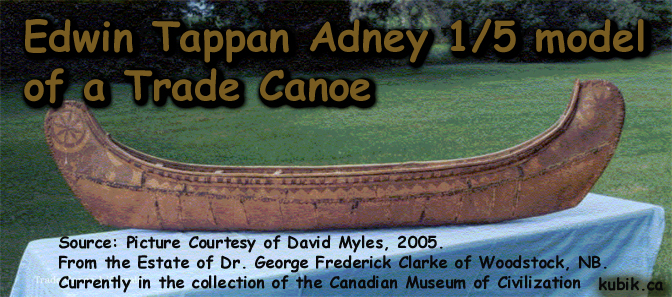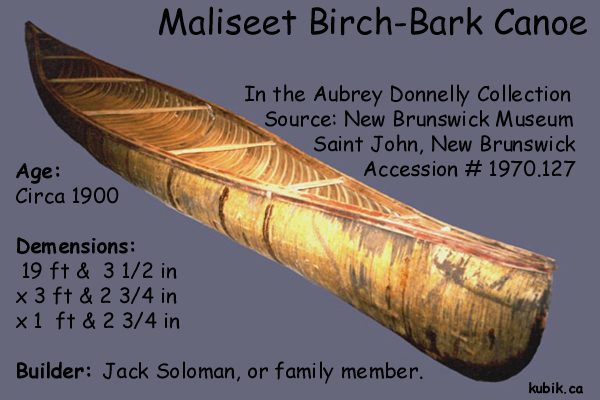The Edwin Tappan Andey Connection.
Not long into our reseach on the Maliseet Trail did
the Trail's connection to Edwin Tappan Adney became clear. In fact,
the moment the extent of that connection became aparent is still fresh
in my memory. It hit like a truck and I've never recovered.
During a visit to a home in NB I looked up to see
an Edwin Tappan Adney model sitting on top of a book shelf! Can you
imagine the sense of shock and awe that cames over one when they see,
almost my accident, an actual Adney model.
Well, thanks to the family of the late Dr. Frederick
Clarke that model is now in the collection of the Canadian Museum of
Civilization. And thanks to the kindness of David Myles here is a picture
of that model before it was shipped from NB to Ottawa. Follow the "Sammy
Solo" icon to like with "Other ETA models from the estate
of Dr G.F. Clarke. (_;__)

One aspect of the Trail that needs more attention
is the Trail's connection to the canoe. Consider that: down river of
the western end of the Trail, we find the Old Town Canoe Company of
Old Town ME; down river of the eastern end of the Trail, we once found
the Chestnut Canoe Company of Frederiction, NB; and almost on the Trail
itself, Adney first learned the art of birch-bark canoe construction
from Maliseet builder Peter Jo. In Someone Before Us, Dr
Clarke tells the details behind Adney's 1890 article "How To Build
A Birch-Bark Canoe" which was published in Harper's Young People.
http://www.siterrific.com/Adney/
There is a line attributed to our late Prime Minister
Trudeau about how God first created the canoe then build the Canadian
landscape to accomidate the canoe. Similarly, there is a line from W.D.
Ganong about how New Brunswick was so perfectly suited to the development
and design of the Maliseet Canoe. If the Canadian landscape, and the
river and streams of NB are perfect for the birch-bark canoe, should
we be surpriced that Adney considered the Maliseet Canoe the most beautiful
of any made by our Canadian first nations?
While on the topic of the Maliseet birch-bark canoe,
below is picture of one which was donated to the NB Museum by the Aubrey
and Willima Donnelly Family of Donnelly Settlement, near Lake George,
NB.
The Donnelly family tells the story of how Aubrey's father
was friends with a man from Kingsclear First Nation, and how the man
stored a canoe on the Donnelly farm which was used by the owner during
the hunting/trapping season. The NB Museum speculates that the man was
Jack Solomon.
My favorite part of the story is that towards the end
of his days, the family friend said if he never returned for the canoe
the Donnelly's could keep it, give it away, or destroy it; however,
if they ever sold the canoe... bad luck would fall on them. After being
stored in a hay loft unused for almost 30 years, the canoe was donated
to the NB Museum in the 1970s. Garnet Donnelly first told me this story
in 1979, and in 2005 when Garnet heard I was looking into the Trail,
he asked me to inquire with the NB Museum for an up date on the canoe.
Museum staff knew the canoe by name, and said that it
was such a fine example of a Maliseet birch-bark canoe that it was used
as a centre peice when "Wolastoqiyik: Portrait of A People"
exhibit was displayed at the NB Museum. Less than 24 hours after asking
about the canoe, the museum provided this jpg and the information which
I embedded into the image.


